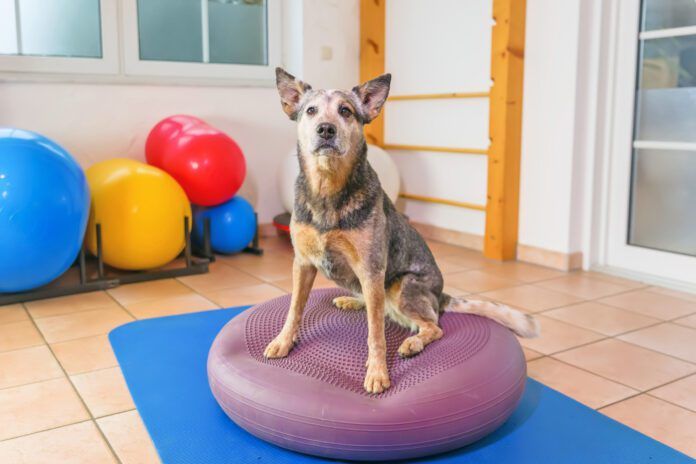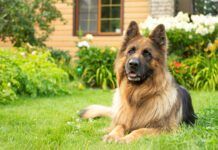All dogs can benefit from dog exercise of some sort, but especially canine conditioning, as it’s appropriate for canine athletes as well as senior couch potatoes and everything in between and beyond, including puppies.
Last summer, I helped a client keep her pup physically exercised while we were going through an intense heat wave in my area. Walks in her neighborhood were out of the question due to hot pavement. The yard was great for short ball play, but the dog needs more than that. That led me down the rabbit hole that is canine conditioning, and I am hooked on this subject. I had no idea that there were so many ways to physically condition dogs with simple but effective exercises like what humans do.
Obviously, before you begin any sort of exercise program for your dog, get approval from your veterinarian. Knowing what to avoid for your pup is important to staying safe, especially if you have a dog with even a tiny bit of arthritis or any kind of joint issues. It also helps to obtain at least a baseline education on dog anatomy. Puppies should not be participating in anything that involves jumping, running on hard surfaces, or balancing until their bones are fully formed.
For dogs who can do cardio, that is a great part of a fitness program. Cardio is anything that uses more lung capacity such as running, swimming, jogging, fetch, agility, and other dog sports. But cardio alone is not canine conditioning.
Fast twitch muscles are utilized in short but intense movements such as the zoomies, intense tug exercises, jumping stair climbing, juking back and forth, and so on.
Canine conditioning for dog sports generally includes specific strength training and/or stretching exercises for the individual sport that a dog is participating in. While strengthening the muscles needed for that sport, it is important to consider the SAID principle, which is equally a consideration for human physical conditioning and strength training.
SAID stands for Specific Adaptation to Imposed Demands. It is believed that muscles, tendons, ligaments, and bones respond to purposeful stress by getting stronger. The physical patterns that are used in each sport being replicated by training gets the body used to those movements. In dog behavior modification, we call this creating new nerve patterns. I expect that it will be similar here. See this website for more on this subject
Now let’s delve into how some of these strength training/stretching exercises can be done at home, even if your dog is not participating in sports. Truly, all dogs can benefit from strengthening their core and muscles.
Stretching Exercises for Dogs
Natural stretches: You can capture your dog stretching when they do it naturally by using a marker word or clicker, if they already know what that means. Once they understand what you are marking, you can put it on cue. My puppy often moves into a sit from a down in to stretch his upper body and his neck, as well as stretching his front legs out with his toes extended. These are excellent stretches to capture. Some people teach their dogs to offer a play bow on cue, and that is also a stretch. The possibilities are nearly endless. Once you mark the behavior consistently, name it to put it on cue.
Figure 8s: Walking in figure 8s like you might do in Rally or zigzagging through weave poles are also versions of stretching. If you’re not training agility, you can lure your dog through poles with either a treat in your hand or a target stick to start. That will also work with figure 8s. Placing objects that you want to curve around for figure 8s will help your dog better understand this process.
Balancing Exercises for Dogs
Teaching your dog to place all four paws on a stable surface is how you start this process. Most dogs already have some sort of cue or even just an inclination to jump up on raised surfaces. If your dog doesn’t, make sure that the initial surface is low enough to not be uncomfortable for that dog. I simply use an “up” cue. Once this is mastered, consider a less stable surface such as a pillow for a small dog or the couch or a large dog bed for a larger dog. The trick here is to work with the dog standing on that surface rather than laying down.
If you have not already taught your dog to stand on cue, start there. I use a flat hand, palm down with fingers tight together, and move my hand face down horizontally from the dog’s nose when they are seated with a small treat between my fingers. I mark the moment that the dog is on all fours and then food reward and then add the cue word when it’s consistently being followed. Make sure that your dog feels safe on the surface with all four paws before you add the cue for this. Balancing uses their muscles in such a way that they strengthen their core. If your dog is more athletic, use a balance/wobble board or even make one with a hard flat surface with a ball underneath one end.
Strengthening Exercises for Dogs
A popular exercise in puppy classes is puppy pushups (also called “puppy aerobics”). This is one of the easiest ways to strengthen your dog with low impact. First get that sit, and then the down. Repeat. You can add a stand in there as well for even more strengthening exercise. Make sure that you are naming/marking/rewarding each step.
If you have ever taken a fun agility class, you have likely seen some of the equipment that can double as conditioning equipment. These include wobble boards, low-set teeter totters, the A-frame (lowered), weave poles, low jumps, ladder walks, and the like. All of these tools help teach body awareness.
Not all of these are right for all dogs needing conditioning, of course. Puppies and senior dogs don’t need to do jumps, teeter totters, or anything that can affect mobility issues. Wobble boards can scare some dogs so there are other options that can achieve the same results such as the soft surfaces mentioned above. Ladder walks teach paw/spatial awareness and help with stability control.
Physical conditioning exercises will keep your dog in top shape while exercising both their body and mind. It’s important to make all the exercises fun with treats for a job well done, never over face your dog with too many repetitions or obstacles he’s not ready for, and—of course—safety first.






